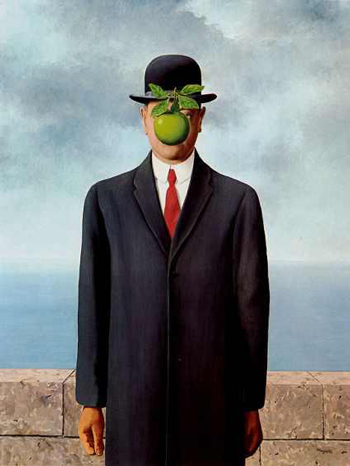| Search Art Prints | ||||||||||||||||||||
| Search Artists | ||||||||||||||||||||

|
||||||||||||||||||||
|
|
|||||||||||||||||||

The Son of Man

|
Magritte's stated life's goal was to overthrow our sense of the familiar, sabotage our habits, and put the real world on trial. In his art, he managed to do just that. Magritte's aim was to use familiar objects to make something decidedly unfamiliar, confrontational, and arresting. With The Son of Man, he unarguable succeeded in doing just that.
The most noticeable detail of The Son of Man upon first inspection is of course the green apple; its presence is sheerly unaccountable. It is also impossible to say whether the apple is moving or stationary, but regardless, it is a blatant contradiction of Newtonian physics. In fact, this is probably a reference to Newton, who was (falsely) said to have come upon his theory of gravitation when struck on the head with a falling apple. The apple's purpose in the painting is to obscure the bowler-hatted man's face, and this function is far more important than the incongruousness of the object itself.
The absurdity of the apple's placement, in fact, draws attention to the fact that we cannot see the man's face; his anonymity is prominently displayed. His pose is suggestive of a man impassive and aloof, and expressive of a strange unusual disinclination and alienation. He seems lonely and stoic. There is nothing about his construction in the painting to make him unique or remarkable. Ultimately, his blankness, his lack of defining characteristics, make him a vehicle for our projections, a mythic figure of sorts. Indeed, Magritte used the bowler-hatted man in many of his paintings. His face is always obscured, turned, or dislocated. His pose or presence is never striking. Through each painting, he remains essentially the same, simply placed in a different context and used to different ends. He is like the hero of myth, never-changing, but simultaneously pantamorphic--a son of man.











